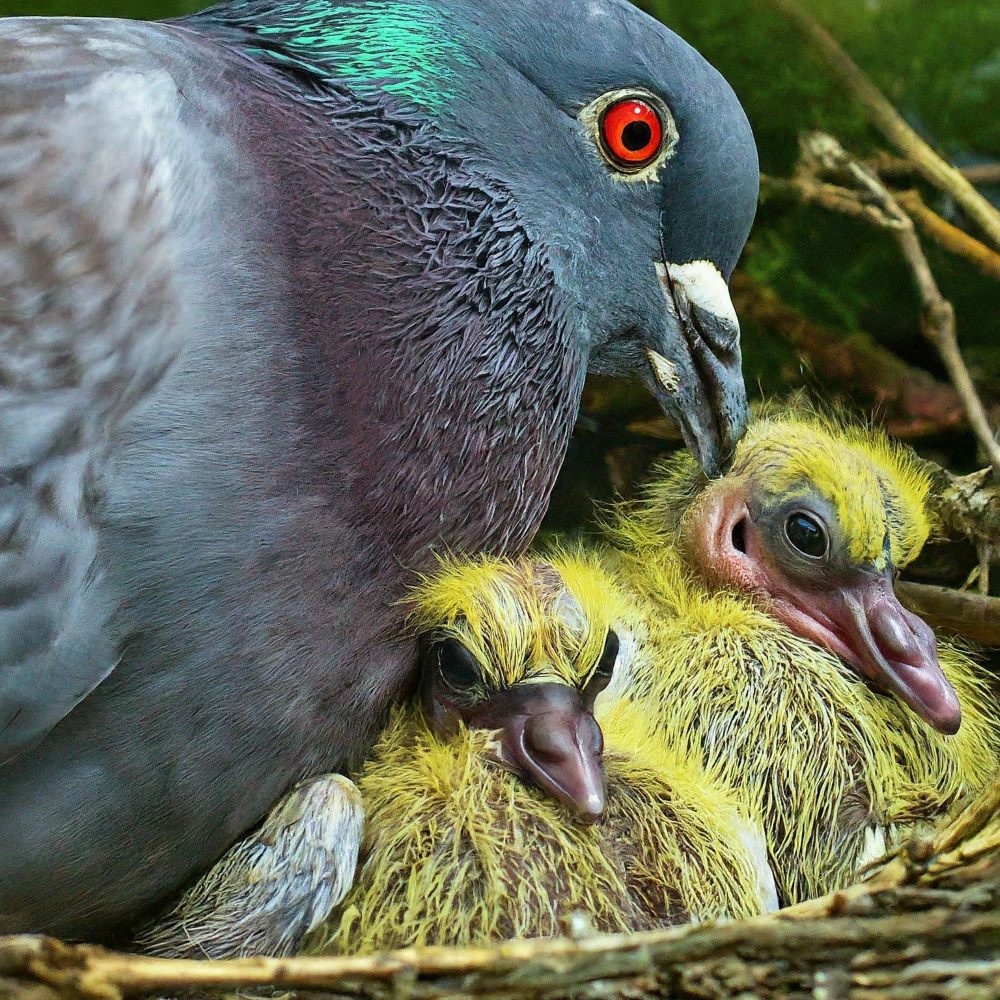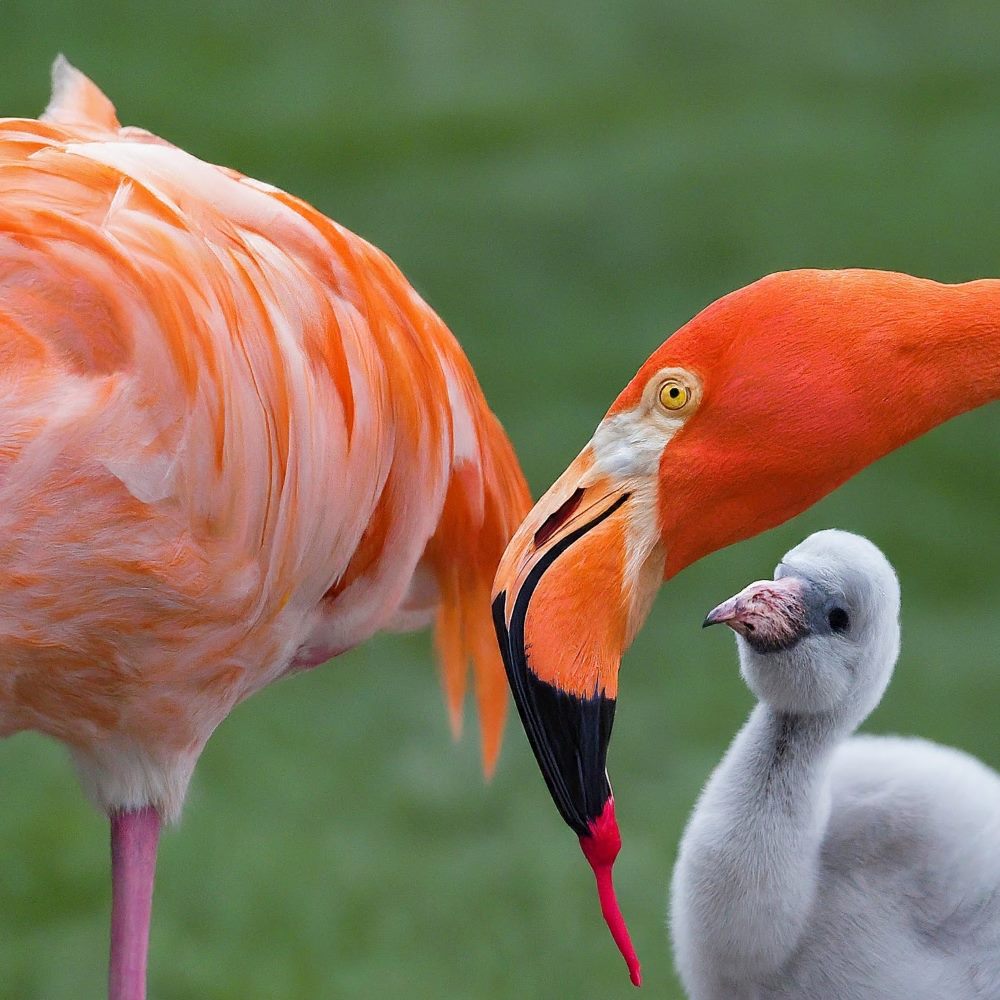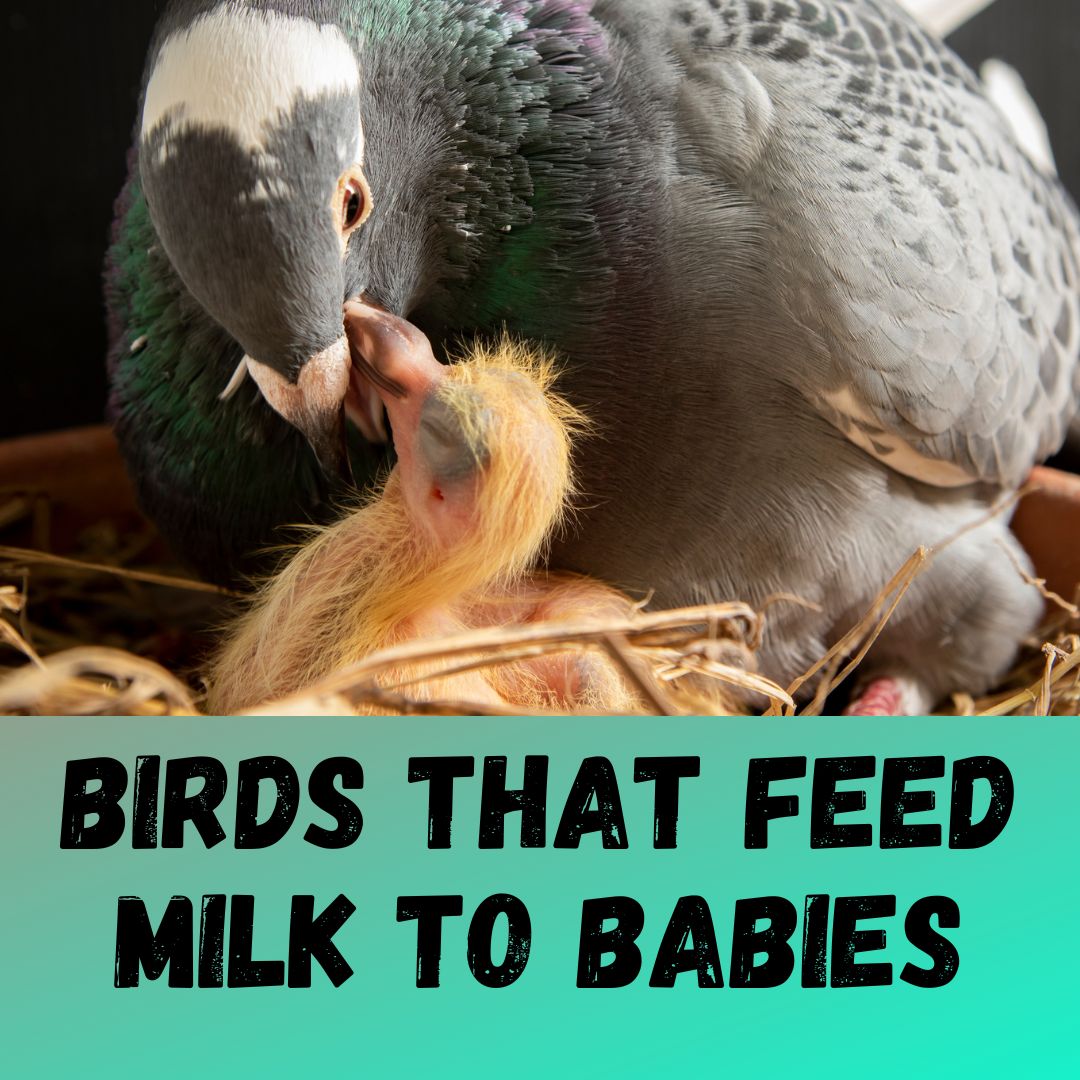When it comes to nurturing their offspring, mammals are well-known for producing milk to provide essential nutrients and promote their young ones’ growth and development. However, did you know that certain bird species have also evolved a fascinating method of nourishing their chicks, akin to milk production? In this article, we will explore the concept of “bird milk” and discuss the bird species that exhibit this unique feeding behavior.
Out of all bird species, only one bird feeds “milk” to its young, and that is the Pigeon. Pigeons produce a unique substance called “pigeon milk” in their crops, which is a highly nutritious secretion that they feed to their squabs (baby pigeons). Pigeon milk is rich in proteins, fats, and other nutrients that are essential for the growth and development of the young birds.
‘Greater Flamingos and Emperor Penguins, on the other hand, do not produce milk to feed their offspring. Flamingos feed their chicks a substance known as “crop milk,” which is a regurgitated mixture of partially digested food, rich in proteins and fats. Emperor Penguins, on the other hand, do not produce milk or crop milk. Instead, they regurgitate partially digested fish and krill to feed their chicks.‘Greater Flamingos and Emperor Penguins, on the other hand, do not produce milk to feed their offspring. Flamingos feed their chicks a substance known as “crop milk,” which is a regurgitated mixture of partially digested food, rich in proteins and fats. Emperor Penguins, on the other hand, do not produce milk or crop milk. Instead, they regurgitate partially digested fish and krill to feed their chicks.
It is important to note that the term “milk” used in relation to birds is different from mammalian milk. While mammalian milk is produced by mammary glands, the “milk” produced by birds is a secretion from specialized structures such as the crop or glands in the esophagus. These secretions serve as an important source of nutrition for the young birds.
Post Contents
Understanding “Bird Milk”
While the term “bird milk” may sound peculiar, it refers to a specialized secretion produced by certain bird species to feed their young. Bird milk is not the same as mammalian milk, as it is not produced by mammary glands. Instead, it is a secretion produced by specialized structures, such as the crop or glands in the esophagus.
It’s interesting to note that this “milk” is different from mammalian milk in several ways. It contains no lactose, the main sugar in mammalian milk, but is rich in proteins and lipids. Additionally, it’s produced in the crop or upper digestive tract instead of mammary glands.
Birds That Produce Milk for Their Young
Bird milk is a highly nutritious substance that serves as a vital source of energy, proteins, fats, and other essential nutrients for the growth and development of young birds. Its composition varies among different bird species, but it generally contains a mixture of proteins, fats, carbohydrates, and antibodies. This unique adaptation allows birds to provide their offspring with a concentrated and easily digestible food source.
Several bird species have evolved the ability to produce milk-like secretions to nourish their chicks. Let’s explore some of these fascinating birds:

1. Pigeons
Pigeons are renowned for their ability to produce a substance called “pigeon milk” to feed their squabs (baby pigeons). Pigeon milk is produced in the crops of both male and female pigeons. It is a thick, yellowish-white secretion that is regurgitated and fed to the young chicks during their early development.
Pigeon milk is rich in proteins, fats, vitamins, and minerals, providing a complete and balanced diet for the growing chicks. It plays a vital role in their growth and feather development. Pigeons typically produce milk for the first few days or weeks after hatching, gradually transitioning their young to solid food as they mature.
2. Flamingos
Certain species of flamingos, including the Greater Flamingo (Phoenicopterus roseus), have a unique method of feeding their chicks known as “crop milk” or “pigeon milk.” Flamingos do not possess a crop like pigeons, but their upper digestive tract produces a milk-like secretion rich in proteins and fats.
Both male and female flamingos produce crop milk, which is regurgitated and fed to their young. This nutritious substance is a vital source of nutrients for flamingo chicks, supporting their rapid growth and development. The production of crop milk in flamingos is stimulated by the hormone prolactin.

Flamingo Crop Milk:
- Origin: Unlike mammals, flamingos don’t have mammary glands to produce milk. Instead, they produce a special nutrient-rich secretion called “crop milk” in their upper digestive tract, specifically the esophagus and proventriculus.
- Nutrition: This red-colored liquid is rich in proteins, fats, and carotenoids, crucial for the rapid growth and development of flamingo chicks. The red color comes from a carotenoid called canthaxanthin, the same pigment that gives flamingos their vibrant pink feathers.
- Feeding Process: Both male and female parents produce crop milk and regurgitate it directly into the chick’s beak. This feeding behavior often involves a unique head-bobbing gesture.
- Duration: Chicks are fed crop milk for the first few months of their lives until they develop the ability to filter feed like adult flamingos.

3. Emperor Penguins
Emperor Penguins (Aptenodytes forsteri) exhibit a unique form of parental care, particularly when it comes to feeding their chicks. While not producing “milk” in the same sense as pigeons or flamingos, they have a fascinating method of nourishing their young.
After the female emperor penguin lays an egg, she transfers it to the male penguin, who incubates it on his feet, keeping it warm with a special brood pouch. During the incubation period, the female goes off to feed in the ocean and returns with a belly full of partially digested fish and krill. She then regurgitates this food, which is often referred to as “penguin milk,” into the chick’s beak.
The “penguin milk” is a rich, oily substance that provides essential nutrients and energy for the chick’s growth. This unique feeding behavior ensures that the young emperor penguins receive the nourishment they need in the harsh Antarctic environment.
Adaptations and Significance of Bird Milk
The ability of certain bird species to produce milk-like secretions for their young showcases remarkable adaptations. Bird milk is highly beneficial for the survival and development of chicks, offering advantages such as:
- Nutritional Balance: Bird milk provides a complete and balanced diet, containing vital nutrients necessary for the growth, development, and feather formation of young birds.
- Digestive Efficiency: The milk-like secretions are easily digestible for the delicate digestive systems of young birds. This efficiency allows them to obtain maximum nutrition from their food source.
- Energy Conservation: By producing and regurgitating nutrient-rich secretions directly into the chicks’ beaks or mouths, parents conserve energy that would otherwise be spent searching for and feeding their young with solid food sources.
- Antibodies and Immunity: Bird milk often contains antibodies and immune factors, offering protection against pathogens and enhancing the chicks’ immune systems during their vulnerable early stages of life.
Mammalian Milk Vs Bird Crop Milk
Milk is a remarkable substance that plays a crucial role in the nourishment and development of young animals. While mammalian milk is widely recognized for its importance in mammal species, certain bird species have also evolved a unique form of nourishment known as crop milk. In this article, we will explore the similarities and differences between mammalian milk and bird crop milk.
Mammalian Milk
Mammalian milk is a specialized fluid produced by the mammary glands of female mammals. It serves as the primary source of nutrition for mammal offspring, providing a balanced blend of proteins, fats, carbohydrates, vitamins, minerals, and other essential nutrients. Mammalian milk is typically secreted during the lactation period, starting shortly after birth and continuing until the young animal is ready to transition to solid food.
Here are some key characteristics of mammalian milk:
- Mammary Gland Production: Mammals possess mammary glands that are responsible for milk production. These glands are modified sweat glands located in the breasts or udders of female mammals.
- Complex Composition: Mammalian milk is a complex mixture of water, proteins (such as casein and whey), fats (including cholesterol and essential fatty acids), carbohydrates (primarily lactose), vitamins, minerals, and immune factors.
- Stage-Specific Composition: The composition of mammalian milk varies throughout the lactation period. Initially, colostrum, a yellowish fluid rich in antibodies, is produced in the first few days after birth, providing vital immunity to the newborn. As lactation progresses, the milk transitions to a more nutritionally balanced composition.
- Adaptation to Offspring: Mammalian milk is specifically tailored to meet the nutritional needs of the offspring. It evolves over time to accommodate the growing requirements of the young animal, providing optimal nutrition for growth, organ development, immune support, and overall well-being.
Bird Crop Milk
Crop milk, also known as pigeon milk or bird milk, is a specialized secretion produced by certain bird species to feed their young. Unlike mammalian milk, crop milk is not produced by mammary glands. Instead, it is produced by specialized structures, such as the crop or glands in the esophagus, and regurgitated for the chicks to consume.
Here are some key characteristics of bird crop milk:
- Crop Production: Crop milk is produced in the crop, a pouch-like structure located at the base of the bird’s throat or upper esophagus. The crop acts as a temporary food storage organ and is responsible for the production of crop milk.
- Simpler Composition: Compared to mammalian milk, crop milk has a simpler composition. It is typically high in proteins, fats, and other essential nutrients but lacks the complex array of components found in mammalian milk.
- Production and Delivery: The parent bird regurgitates the crop milk to feed the chicks directly. It is typically fed to the young birds by regurgitation or by direct beak-to-beak contact.
- Limited Production Period: Birds that produce crop milk usually produce it for a relatively short period, typically during the early stages of chick development. As the chicks mature, the parents gradually transition them to solid food sources.
Similarities and Differences
While mammalian milk and bird crop milk share some similarities in their role of nourishing offspring, they also have significant differences:
Similarities:
- Both mammalian milk and bird crop milk serve as essential sources of nutrition for the growth and development of young animals.
- Both contain proteins, fats, and other nutrients necessary for the young animals’ well-being.
- Both are produced by parents as a means of providing optimal nutrition to their offspring.
Differences:
- Mammalian milk is produced by mammary glands, while bird crop milk is produced in specialized structures like the crop or esophageal glands.
- Mammalian milk has a more complex composition, containing a diverse range of nutrients, while bird crop milk has a simpler composition, often rich in proteins and fats.
- Mammalian milk is typically produced for a more extended period, providing nutrition throughout the lactation period, whereas bird crop milk is produced for a shorter duration during the early stages of chick development.
- Mammalian milk is consumed directly from the mother’s nipples, while bird crop milk is regurgitated and fed to the chicks orally.
Conclusion
While mammalian milk production is widely recognized, the concept of “bird milk” is a fascinating adaptation observed in certain bird species. Pigeons, flamingos, and emperor penguins employ various mechanisms to produce nutrient-rich secretions that serve as vital sources of nourishment for their young. These unique feeding behaviors highlight the remarkable diversity and adaptability of birds in caring for their offspring. Through the production of milk-like secretions, these birds ensure the survival and successful development of their chicks in their respective environments.
Bird milk is a testament to the intricate strategies that have evolved in the animal kingdom to support the growth and survival of offspring. Further research into the composition and mechanisms of bird milk production will continue to unveil the secrets behind this fascinating phenomenon.

94% of pet owners say their animal pal makes them smile more than once a day. In 2007, I realized that I was made for saving Animals. My father is a Vet, and I think every pet deserves one. I started this blog, “InPetCare”, in 2019 with my father to enlighten a wider audience.
